The Phone Art Box Project is on the line
*
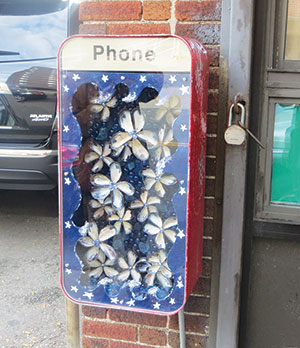
Can you hear me now? If not, you may be talking into the wrong box, ever since the Somerville Arts Council’s Phone Art Box Project has come to town, turning old phone boxes into new works of art.
By Blake Maddux
Located directly in front of Somerville High School, the intersection of Highland and Vinal Avenues is a spot that many motorists and pedestrians pass on a daily basis without giving it a second thought.
Sunday, October 27, however, a modest crowd – including children who had come with their parents – assembled here in order appreciate a new addition alongside the heavily traveled thoroughfare.
Shortly before 2 p.m., artist Rachel Mello began setting up a table on which to place coffee and hot cider from Diesel Café, as well as strawberries and gluten-free cookies that she picked and baked herself.
The occasion on this brisk and slightly windy afternoon was a planned tour of several unattended phone boxes that have served as canvases for local artists.
The Phone Art Box Project is, like the Switchbox Project before it, an effort on the part of the Somerville Arts Council to transform into objects of beauty that which would otherwise go (at best) unnoticed.
Mayor Joseph Curtatone appealed to the Somerville Arts Council to join forces with the Nave Gallery for this endeavor. Gregory Jenkins, Director of the Somerville Arts Council, and Nave Gallery Director Susan Berstler were both on hand for each of the tour’s six stops.
As the 2 p.m. starting time approached, the 20 or so individuals who were present busied themselves with lively conversation, which included the inevitable talk of the previous night’s World Series game. With the passing of several more minutes, it was clear that Mayor Curtatone, who was scheduled to lead the spectators from phone box to phone box, would not be arriving.
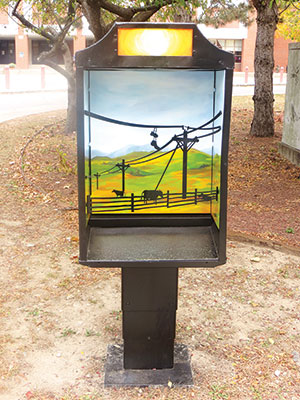
This is a long distance call. By Rachel Mello
Therefore, Rachel Mello unassumingly began fielding questions and comments about “This Is a Long Distance Call,” which is her contribution to the Phone Art Box Project.
After admiring Mello’s work, Berstler and Jenkins led other interested attendees a couple of blocks down to Highland Pizza. This is the location of an as yet untitled piece by Jude Griffin, who is an instructor at the Quincy Art Association.
“I was thinking about calling it ‘Sea Flowers’,” Griffin said, “because it’s made of seashells in a flower shape.”
In contrast to the pastoral scene on display in Mello’s phone box, Griffin said that the graffiti and chipping paint on the side of the box that she used gave it an “urban look” and provided an engaging juxtaposition with her creation.
“Collecting the right mussel shells took a long time,” she explained. “I collected a big bucket, but I ended up being able to use only about 20 percent of them.”
Ahmed Sheikh, the owner of Highland Pizza, described the piece as “beautiful.”
“They did a nice job,” he added. (“They” are Griffin and her husband Doug Biggs, whom Griffin credited as the co-artist.)
However, Sheikh did encourage Griffin to repaint the sides of the box, which she has agreed to do.
“I really love the idea of reclaiming these old, rusty eyesores for public art,” Griffin said. “We noticed that people are walking by the store as they always do, and then as they pass the box, they double back. People are taking cell phone photos. It’s been fun.”
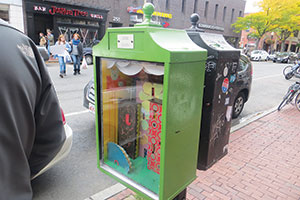
By Joe Barillaro
Mayor Curtatone remained a no-show at subsequent stops at Hub Glass, the location of Pauline Lim’s “We Have to Talk,” and in Ball Square, where one will find “Little Library” by Akil Williams and James Fox. (The name of the latter is literal – it contains an inventory of free books that the Friends of the Somerville Public Library restocks each week.)
The last two phone boxes of the tour were in Davis Square, where Gary Duehr, the manager of Bromfield Gallery in the South End, was on hand to discuss “Fossil Phone.”
Duehr described how he created his contribution, which he had completed before he had even heard about the Phone Art Box Project:
“The phone is made of plaster, and it’s cast by taking a real phone and pressing it into some damp sand, and into that impression you pour plaster. And out comes something that looks like that. I always thought it kind of looked like a fossil, and then I heard about the Phone Art Box Project, and went, ‘Wow, that would be a perfect home for it!’”
It was at “Phone Fossil,” which is right beside a fully functioning pay phone on the Holland Street side of the Davis Square T, that Mayor Curtatone finally appeared.
“I came straight from my son’s game,” he explained. “I didn’t even have time to change.”
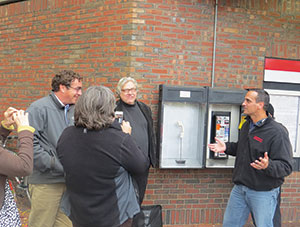
Phone Fossil by Gary Duehr
Curtatone was enthusiastic in his support of the Phone Art Box Project, saying, “It’s another great opportunity to celebrate the arts, and to display something about who we are, about originality, our creativities, our innovation … [T]he creative base in the city has done so much to not just promote place and a sense of neighborhood, but to bring neighborhoods and people together to really invest in social bonds and ties that really build a community.”
The tour concluded on the Elm Street sidewalk near Found, which is the site of Joseph Barillaro’s “CityScape.”
Most people will probably view the Phone Art Box Project as a successful, if humble, attempt at street beautification. However, Jude Griffin made a poignant observation that confirmed how progress – even on a comparatively small scale – can have its adverse effects on some individuals.
Referring to the box that might soon be called “Sea Flowers,” she said, “A panhandler has been using it to leave their panhandling cups. I had to put the cup underneath. I wanted to put a little apology sign: ‘Sorry!’”
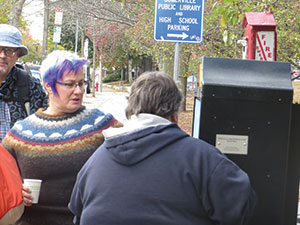
– Photos by Blake Maddux














Reader Comments